ssMaritime.com
Please Note: Firefox and some other search engines may not suitable
Please use Google Chrome for this page to load perfectly!
With Dr. Reuben Goossens
Maritime Historian, Author, Lecturer & Cruise‘n’Ship Reviewer
Commenced in the Passenger Shipping & Cruise Industry in 1960
Please
Note: All ssMaritime and other related maritime
sites are 100% non-commercial and privately owned, thus ssmaritime is NOT
associated with any shipping company or any other organisation! Although the
author has worked and been involved in the passenger shipping industry for well
over 63 years, but due to his old age and poor health, he has been forced to
retire. Yet, he has completed well over 1,580 Classic Liners, Passenger-Cargo
Liners as well as humble converted C3 converted Migrant Liners, which has
transported countless thousands of folk to the new world, as well on
vacations’. Amazingly; ssmaritime.com has received 7.57 billion
visitors to date (Last update: August 4, 2023). I trust the features online
will continue to provide Classic Liner and Ship enthusiasts both the
information they are seeking, but more so provide a great deal of pleasure and relive many happy memories! Features online are 1 from
web-page to a huge 25 web-pages covering the life of a single ship.
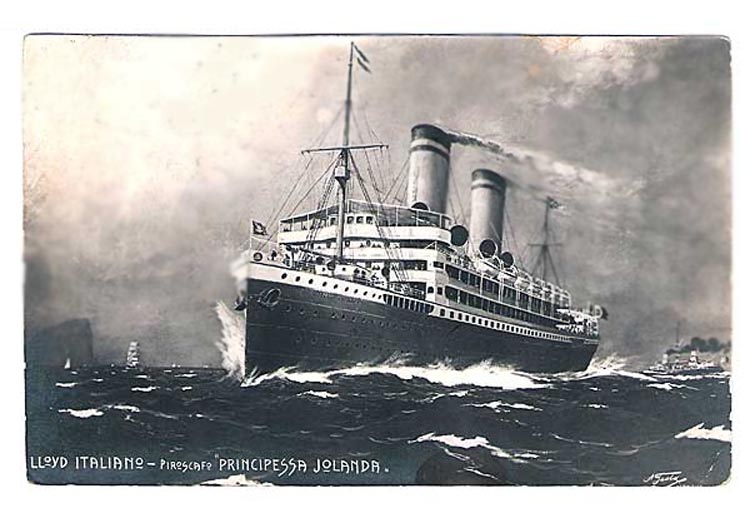
And early pre launch Postcard of the S.S. Principessa Jolanda
This is certainly not a story of a ship that had a wonderful long life at sea, in fact it is the very opposite as you will soon find out. But as it was a super luxury liner, which should have sailed the oceans for a good thirty or so years I found it worth adding this rather sad story.
*************************
The S.S. Principessa Jolanda Tragedy
Introduction:
The S.S. Principessa Jolanda was an Italian Transatlantic Ocean Liner built by “Cantiere Navale di Riva Trigoso” for the “Navigazione Generale Italiana” (NGI) Shipping Company. She was named after Princess Yolanda of Savoy, the eldest daughter of King Victor Emmanuel the 3rd, the ship was to operate on the NGI’s South American service.
The builder spent two years dedicated to the
construction of the State of the art Liner the S.S. Principessa
Jolanda, which was the Namesake of King Victor
Emmanuel III’s eldest daughter, Princess Yolanda of
Upon completion she was 9,210 GRT (Gross Registered
Tons) and 141 m or 463 ft long, and
she was the largest Passenger Liner built in
Besides all the aforementioned, her interiors for those days were simply sumptuous and so elegant, as we can see below, which came from a brochure:
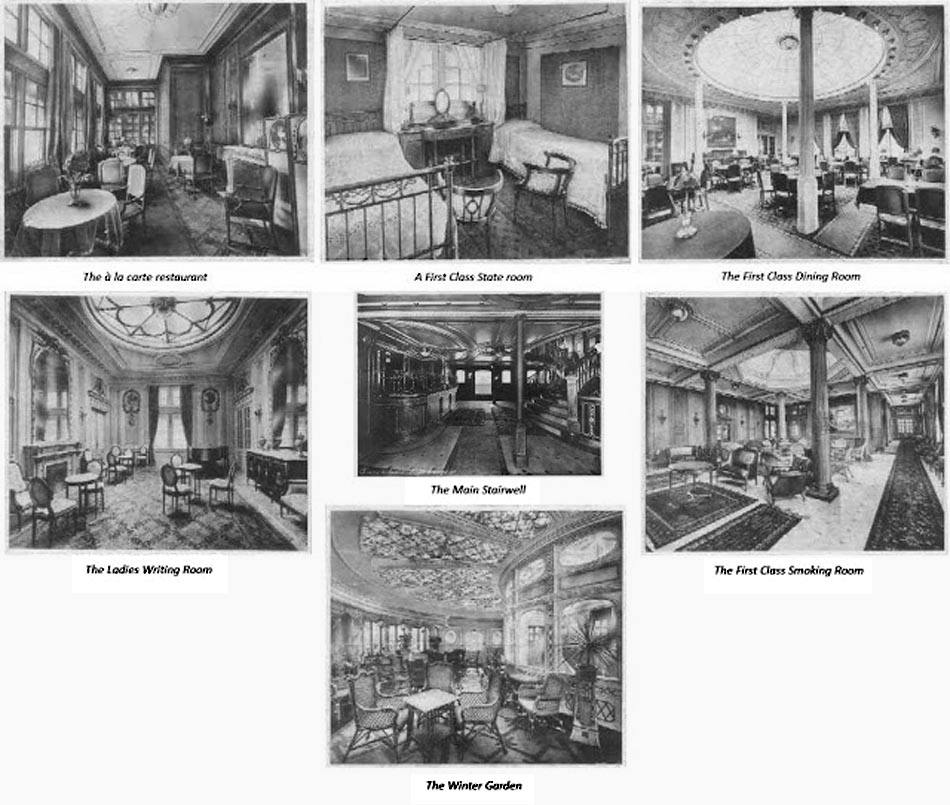
The Launching:
On September 22, 1907 at 12:25 pm, the almost fully completed “Principessa Jolanda” was launched before all the officials, government officials as well as local and foreign journalists. There was also a huge audience of onlookers wanting to see this magnificent ship enter the water!
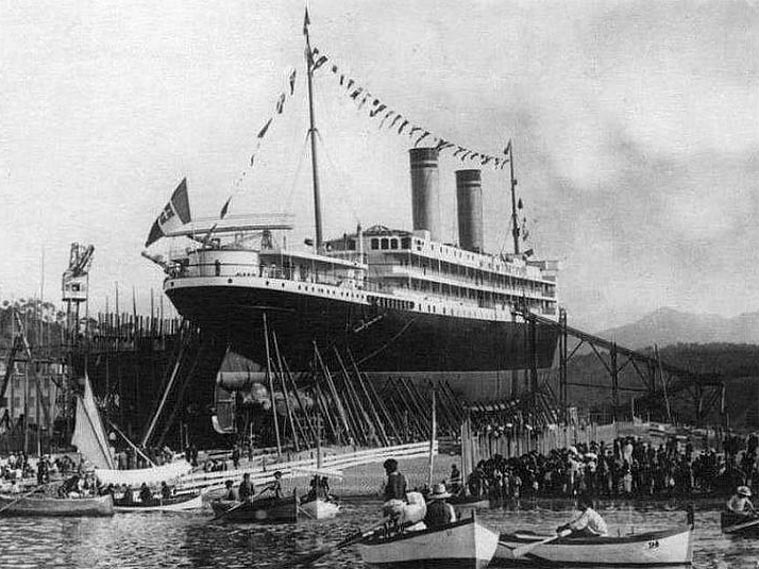
Above: A crowd ashore and in small boats as the ships sits there looking stately!
Below: She is seen sliding down the slipway, a little faster than she
should and hits the water with a huge splash!
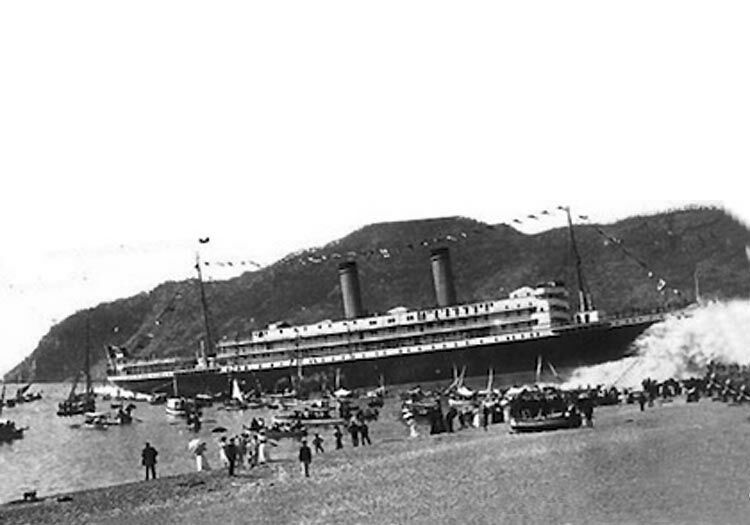
Having had the official launching she slid down
the slipway rather rapidly, however very much as soon as she entered the
water the ship became unstable and she heeled rapidly
to port. There was
an immediate effort’s by tugboats and shipyard workers to rescue the
situation, including lowering the anchors to starboard to counteract the
movement, but all effort’s were unsuccessful.
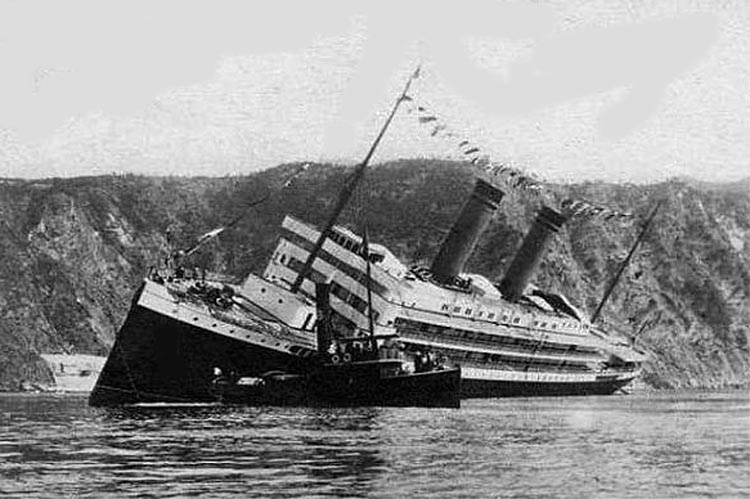
Above & Below: Here we see her heeled to port and it is only going to get worse
and guests on board and crew disembarking.
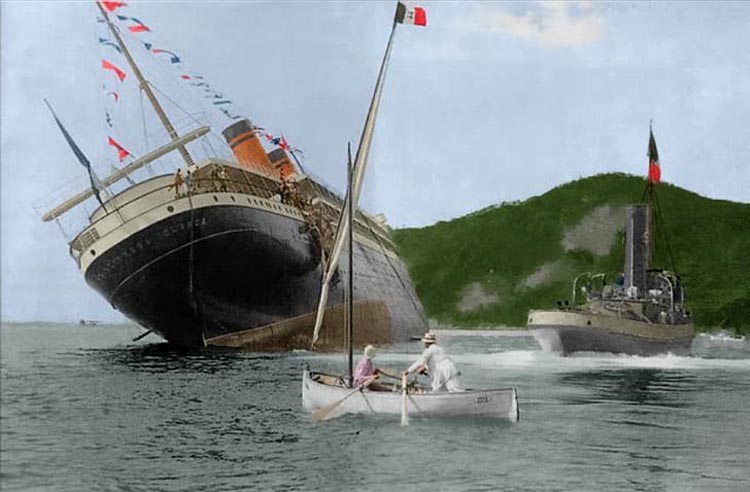
Water has by now pouring in via the open portholes in the lower and the upper decks in her hull.
And soon her decks will be under water and she will go down
Sadly after 20 minutes the Ship’s list was so much that she commenced to take on water through openings in the upper decks and she rapidly capsized. Just her funnels were showing just above and parallel to the water. Her Captain and his guests and some of the workers that were onboard had only just enough time get off the ship in her lifeboats. Thankfully there was not a single casualty. It was within an hour this magnificent ship finally slid lower until only a just few feet of her starboard side was visible.
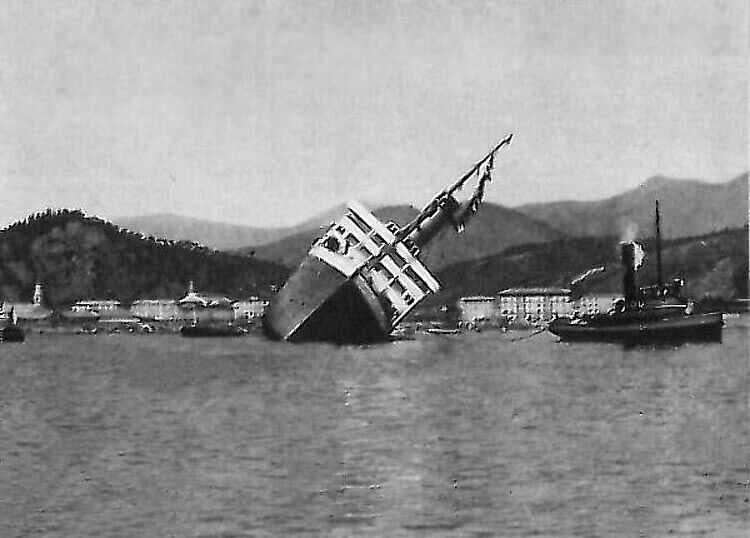
Here we see what I described above, soon it proved to be this fine ships’ end!
Considering she was a new ship, yet it was decided she was unsalvageable and tragically this magnificent Liner’s wreck was broken up on site. Her engines were salvaged and of course used again on another ship believed to be the S.S. Milazzo.
Why did she Capsize & Sink?
The technicians at the shipyard decided that launching the “Principessa Jolanda” ‘having been completed with her upper superstructure fitter as well as her tall funnels, etc, and all her fittings were already onboard as well as all furnishings installed. However, there not any coal or ballast on board and that resulted in the centre of gravity above being far too high and heavy. Once the ship began heeling, a large amount of movable material increased the list, an example of the free surface effect involving solid objects as opposed to the more common liquids. Water entered through portholes and other openings in the superstructure as the ship heeled over. These and other errors, such as launching the ship too rapidly, caused the fatal instability and that led to this disaster.
It was further theorized that the abrupt change in transverse rotational axis during the ship's descent down the long launch ramp caused the bow to press against the chute itself as the stern hit the water. This may have caused a crack somewhere in the keel, contributing to admission of water to the hull. Regardless of the exact cause, it was eventually determined that full responsibility for the loss of the steamship was due to the shipyard's technical mistakes during launch and not in the design or construction of the vessel. Thus the loss of this fine ship was totally due to her builder “Cantiere Navale di Riva Trigoso” who made far too many errors!
*************************
Specifications:
Name:………………………………………..Principessa Jolanda.:
Owner:……………………………………….Navigazione Generale Italiana. (NGI).
Namesake:…………………………………Princess
Yolanda of
Type:………………………………………….Passenger Liner.
Builder:………………………………………Cantiere Navale di Riva Trigoso.
Launched:………………………………….September 22, 1907.
Tonnage:……………………………………9,210 GRT.
Length:………………………………………463 ft - 141 m.
Beam:………………………………………..56 ft - 17 m.
Propulsion:…………………………………Two triple-expansion steam engines making 15,000 shp.
Propellers:………………………………….Twin screws - 10,500 hp.
Speed:……………………………………….18 knots - 33 km/h.
Accommodations:………………………1,530 Total Passengers.
……………………………………………………180 First Class.
……………………………………………………150 Second Class
……………………………………………………1,200 Third Class.
Crew:………………………………………….860.
Cargo:………………………………………..300 tones of cargo, 600 bags of mail, and 250,000
gold Lire.
Notes:………………………………………..Two funnels & two masts.
Fate:…………………………………………..She
Capsized and heeled to port and sunk upon her launching.
*************************
Her Newer Sister Ship also Sank:
When the “Principessa Jolanda”
was launched, was during the construction of her sister ship
the S.S. Principessa Mafalda,
which was well on the way, as her framework was almost completed. The “Mafalda” was launched on October 22, 1908 with much of
her superstructure having been uninstalled in order to prevent the
same disaster and her launch was thankfully successful. She was fully
completed in March 1909. “Principessa Mafalda” now became the flagship of the NGI.
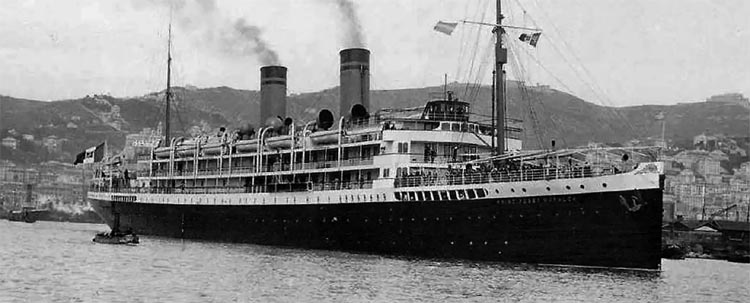
The S.S. Principessa Mafalda is seen in her prime.
Besides her South American service, she also
served during World War I. However, having served for just 18 years, in
October 1927, the “Mafalda” was for some reason
in a very poor condition and she ended up sinking in a another disaster on
October 25, 1927 some 80 miles off Salvador de Bahia, Brazil.
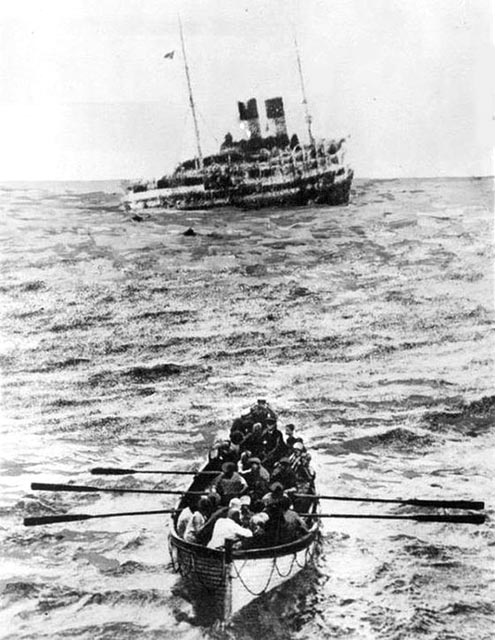
Deserting a sinking ship on October 25, 1927
Above: the sad view of her commencing to sink and things look bad.
Below: lifeboats have passengers onboard, but there are people in the sea
and there are at least four or five people seen in the sea looking desperate.
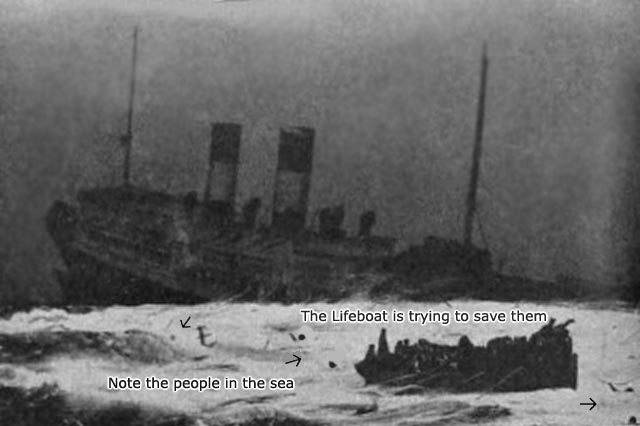
For interest the S.S. Principessa Mafalda specifications were much the same as the S.S. Principessa Jolanda, with the same number of passengers and engines etc.
*************************
“Blue Water
Liners sailing to the distant shores.
I watched them come, I watched them go and I
watched them die.”
****************************
Amazingly; ssmaritime.com has received 7.57 Billion in the past 33 years
(Last update: August 4, 2023).
For interest: Sadly an email
service to ssMaritime is no longer available, due to the author’s old age
and chronic illness as well as being disabled, etc.
In the past ssMaritime received over 120 emails per day, but Dr. Goossens can
no longer handle these and I am only here several days a week, and Eng his
carer is just far too busy looking after him now. Dr Reuben sincerely regrets
this!
Visit more ships on this page or return to
the Main Page!
Visit the ssMaritime.com Mainpage.
Where the ships of the past which continue to
make history
Featuring
well over 1,580 Classic Passenger Liners, Passenger-Cargo Liners
& Classic Cruise Ships!
Photographs on ssmaritime and associate pages are by; the author or from the author’s private collection. In addition there are some images that have been provided by Shipping Companies and private photographers or collectors. Credit is given to all contributors. However, there are some photographs provided to me without details regarding the photographer/owner concerned, so sorry if this is the case.
This notice covers all pages; although, and I have done my best to ensure that all photographs are duly credited and that this notice is displaced on each page, that is, when a page is updated!
ssMaritime is owned & © Copyright by Reuben Goossens - All Rights Reserved

